太阳诱导叶绿素荧光遥感技术在TECIS-1卫星上的应用前景
引用次数: 4
摘要
太阳诱导的叶绿素荧光(SIF)在植被光合作用监测中的重要性已引起生态和遥感研究界的广泛关注。近年来,由于大气卫星的快速发展,星载SIF产品得到了广泛的应用。SIF成像光谱仪(SIFIS)是即将发射的陆地生态系统碳清单卫星(TECIS-1)上的有效载荷,专为SIF监测而设计。我们进行了原位实验,通过与商用光谱仪QE Pro的比较,来评估SIFIS在光谱测量和SIF检索方面的性能。在不考虑两种光谱仪采集数据的时空不匹配的情况下,SIFIS和QE Pro同步获得的辐射光谱具有较高的一致性。推扫帚图像的SIF检索、归一化植被指数(NDVI)和植被近红外辐射(NIRvR)结果显示,植被和非植被表面的空间分布一致。通过严格过滤匹配像素进行定量比较。在远红波段,SIFIS与QE Pro的SIF检索性能具有较高的相关性,R2=0.70, RMSE=0.30 mW m−2 sr−−1 nm−1。然而,红色波段的相关性相对较差,R2值为0.23,RMSE为0.26 mWm - 2sr- - 1nm - 1。尽管该实验存在很大的不确定性,但结果表明,TECIS-1在发射后应该提供可靠的SIF监测性能。本文章由计算机程序翻译,如有差异,请以英文原文为准。
Prospects for Solar-Induced Chlorophyll Fluorescence Remote Sensing from the SIFIS Payload Onboard the TECIS-1 Satellite
The importance of solar-induced chlorophyll fluorescence (SIF) to monitoring vegetation photosynthesis has attracted much attention from the ecological and remote sensing research communities. Space-borne SIF products have been obtained owing to the rapid development of atmospheric satellites in recent years. The SIF Imaging Spectrometer (SIFIS) is a payload onboard the upcoming Terrestrial Ecosystem Carbon Inventory Satellite (TECIS-1) that is specifically designed for SIF monitoring. We conducted an in situ experiment to evaluate the performance of SIFIS on spectral measurement and SIF retrieval through comparison to the commercial spectrometer QE Pro. Disregarding the spatiotemporal mismatch between the collected measurements of the two spectrometers, the radiance spectra obtained synchronously by SIFIS and QE Pro showed a high level of consistency. The SIF retrieval, normalized difference vegetation index (NDVI), and near-infrared radiance of vegetation (NIRvR) results for a push-broom image shows consistent spatial distributions over both vegetated and nonvegetated surfaces. A quantitative comparison was conducted by strictly filtering matching pixels. For the far-red band, a high correlation was obtained between the SIF retrieval performances of SIFIS and QE Pro with R2=0.70 and RMSE=0.30 mW m−2 sr−−1 nm−1. However, a relatively poor correlation was observed for the red band with an R2 value of 0.23 and an RMSE of 0.26 mWm−2sr-−1nm−1. Despite the large uncertainties associated with this experiment, the results indicate that TECIS-1 should offer a reliable SIF monitoring performance after its launch.
求助全文
通过发布文献求助,成功后即可免费获取论文全文。
去求助
来源期刊

遥感学报
Social Sciences-Geography, Planning and Development
CiteScore
3.60
自引率
0.00%
发文量
3200
期刊介绍:
The predecessor of Journal of Remote Sensing is Remote Sensing of Environment, which was founded in 1986. It was born in the beginning of China's remote sensing career and is the first remote sensing journal that has grown up with the development of China's remote sensing career. Since its inception, the Journal of Remote Sensing has published a large number of the latest scientific research results in China and the results of nationally-supported research projects in the light of the priorities and needs of China's remote sensing endeavours at different times, playing a great role in the development of remote sensing science and technology and the cultivation of talents in China, and becoming the most influential academic journal in the field of remote sensing and geographic information science in China.
As the only national comprehensive academic journal in the field of remote sensing in China, Journal of Remote Sensing is dedicated to reporting the research reports, stage-by-stage research briefs and high-level reviews in the field of remote sensing and its related disciplines with international and domestic advanced level. It focuses on new concepts, results and progress in this field. It covers the basic theories of remote sensing, the development of remote sensing technology and the application of remote sensing in the fields of agriculture, forestry, hydrology, geology, mining, oceanography, mapping and other resource and environmental fields as well as in disaster monitoring, research on geographic information systems (GIS), and the integration of remote sensing with GIS and the Global Navigation Satellite System (GNSS) and its applications.
 求助内容:
求助内容: 应助结果提醒方式:
应助结果提醒方式:


